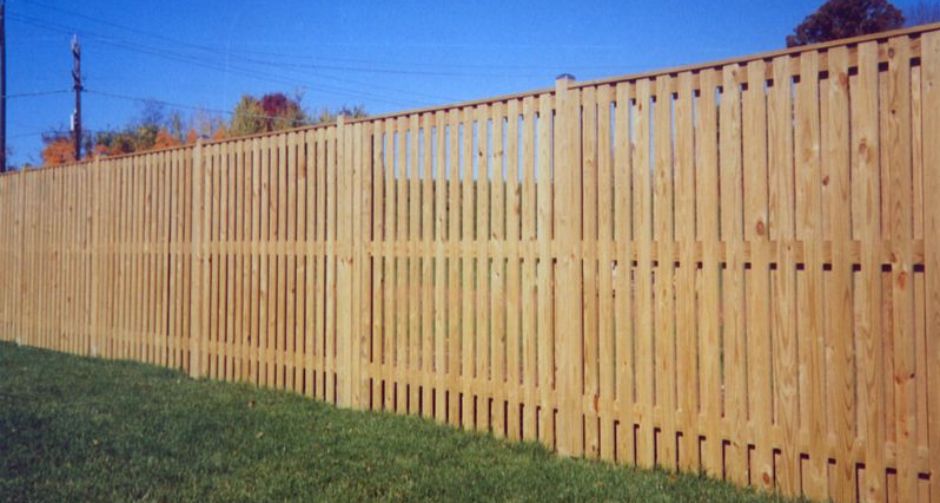Whether you already have a wood fence from a previous homeowner, or you installed one on your own, residential wood fence maintenance is the most financially-sound decision to avoid excessive spending on replacement fencing in the future. Replacing your wood fence might seem like an easy route to take, but you are much better off maintaining your existing one to maximize its longevity and appearance.
Check for Damage
Checking for damage on a wood fence requires thoroughly inspecting the entire fence. Start by visually inspecting the fence, looking for cracks, splits, or warps in the wood. Pay close attention to areas near the ground where moisture and rot are more likely to occur. Tap on the wood with a hammer to see if it sounds solid or if it feels spongy, which could indicate rot. Look for signs of insect damage, such as holes, sawdust, or insect droppings. Check the fence posts for any signs of warping or leaning, and inspect the hardware for any loose nails or screws. If you find any damage, mark it for repair and take action as soon as possible to prevent further damage and maintain the fence’s longevity.
Rent or Purchase a Pressure Washer for Residential Wood Fence Maintenance
A pressure washer is by-far the best way to clean your wood fence. Residential wood fence maintenance becomes easy when you rent or purchase a pressure washer. Chemicals can be too harsh and cause more problems to your wood fence, so sticking with natural cleaners is the best solution. It is important to be patient with this process as it is not hard, but can take some time to get it extremely clean.
Get the Necessary Repairs for your Residential Wood Fence Maintenance
If any cracks, rot, warped, broken, or damaged parts are along your wood fence, you should have these areas inspected by a professional and fixed through replacements. It is not required to get an entirely new fence when your current wood fence is a little damaged, and a professional can make sure the fixes are done in a manner that will help your wooden fence last as long as possible. Consider checking on your fence periodically for the best residential wood fence maintenance.
Stain and Stain Your Wood Fence
Sanding and staining a wood fence is important to maintaining its appearance and protecting it from moisture and UV rays. First, remove any loose or peeling paint or stain to sand a wood fence. Then, use a belt or orbit sander with medium-grit sandpaper to sand the entire fence. Make sure to sand in the direction of the grain to avoid damaging the wood. After sanding, remove any dust with a clean cloth. To stain the fence, choose a high-quality, oil-based wood stain that is suitable for outdoor use. Apply the stain with a brush, roller, or sprayer, and cover all surfaces evenly. Allow the stain to dry completely, following the manufacturer’s recommended drying time, and then apply a second coat if desired. Remember to wear gloves and protective eyewear while sanding and staining to protect yourself.
Seal the Ends of the Boards
Sealing the ends of boards on a wood fence is important to protect against insects and water damage. To do this, use a high-quality, water-resistant wood sealant designed for outdoor use. Start by cleaning the ends of the boards to remove any dirt or debris. Then, using a brush or a roller, apply the sealant to the end grain of each board, making sure to cover all exposed surfaces. Allow the sealant to dry completely, following the manufacturer’s recommended drying time, and then apply a second coat if desired. The sealant will help protect the wood from moisture and prevent insects from burrowing into the end grain, which is a common entry point for pests. Sealing the ends of the boards will also extend the fence’s life and maintain its appearance.
Trim Away Vegetation
Trimming vegetation away from a wood fence is important to prevent damage from roots or branches. Begin by identifying any vegetation, such as trees, shrubs, or grass that is growing too close to the fence. Use a pair of pruning shears or a hedge trimmer to carefully cut back any branches or foliage that are in contact with the fence. Take care not to damage the fence or the vegetation. For larger trees or shrubs, use a chainsaw or a handsaw to remove branches that are too close to the fence. When finished, dispose of any cuttings properly to avoid attracting pests or creating a fire hazard. Regularly trimming vegetation away from the fence will help maintain the appearance and integrity of the fence and prevent damage over time.
Tighten Loose Nails and Screws
Tightening loose hardware on a wood fence is a simple maintenance task that helps prevent the fence from becoming wobbly. Start by inspecting the fence for any nails or screws that are loose or missing. Use a drill or screwdriver to tighten any loose screws, making sure to tighten them to the manufacturer’s specifications. If any nails are loose, remove them and replace them with screws, which are stronger and will hold the fence more securely. Make sure to use screws that are appropriate for the type of wood and the conditions in which the fence is installed.
Do not underestimate the ability of a restored wooden fence to look great. Contact a qualified fence company for any questions you may have or to discuss your options for fixing the damaged parts of your fence for restoration.
Read More:

